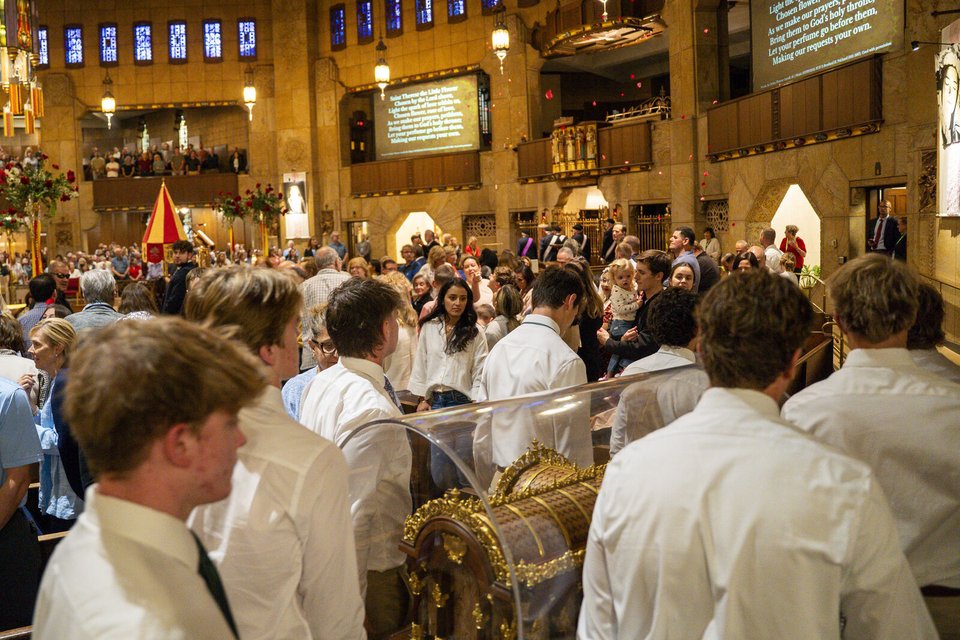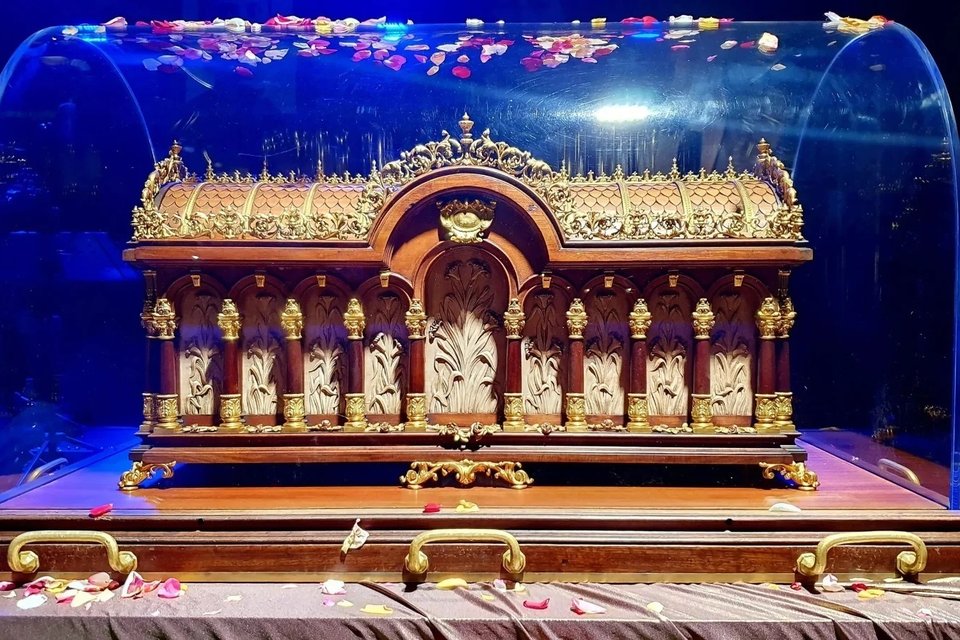AIP Speaker Series' fifth season ends with biography of St. Rita and insights into Pope Leo XIV from a Midwest Augustinian friar
PLYMOUTH — Fr. Tom McCarthy, OSA, spoke about his “two close friends” to close out the fifth season of the "Anything is Possible" Speaker Series at St. John’s Resort on May 27.
Those two friends happened to be St. Rita of Cascia and the man he knew as Fr. Robert Prevost, OSA, but the world now knows as Pope Leo XIV.
“I’m very grateful that I get to talk about a very dear friend of mine, St. Rita,” Fr. McCarthy said. “Then, I’m going to talk about another dear friend, Pope Leo, but we’ll start with ladies first, OK?”
Fr. McCarthy is the vocations director of the Midwest Province of the Order of St. Augustine and director of the St. Rita of Cascia Shrine Chapel in Chicago. He told the story of St. Rita of Cascia, a woman born in Roccaporena, Italy, in 1381 who lived a life Fr. McCarthy described as simple, but profound.
St. Rita was born to older parents in the small hamlet of Roccaporena, just outside Cascia, where Augustinian nuns lived.
“You would think with two devout parents they’d be happy to see Rita become a nun, but they told her, ‘No,’” Fr. McCarthy said. “They said, ‘Rita, you have to take care of us.’ Back in the day, there was no Social Security, no pensions. You had to be taken care of by your children. They were not being selfish. They were being realistic."
Rita’s parents arranged for a man named Paolo Mancini to marry Rita, whom Fr. McCarthy described as a “mafia-type guy” and a local mob enforcer.

Rita’s holiness converted Paolo, and the two lived a simple, pious marriage where Paolo left his mob activities, and they raised two sons.
But tragedy struck when another mobster took Paolo’s conversion as a sign of weakness and attacked and killed him as he was heading home from work. Their two sons swore a vendetta against the man who killed Paolo, and Rita prayed for her two sons not to take revenge, worrying for their souls.
“She loved them so much, she prayed, ‘God, take them to you, please take them to heaven so they don’t commit this horrible sin, this murder,'” Fr. McCarthy said. “That’s the love of a parent who would do anything for their child, even if that means sending that child back to God. Very shortly after that, they died of natural causes.”
Rita was now alone, with her parents, husband and two sons deceased.
“She was alone, but she wasn’t lonely,” Fr. McCarthy said. “She mourned and she mourned appropriately. But who was the center of her life? Jesus Christ. She used to climb this hill in Roccaporena and pray, and when she prayed, she thought, ‘I’ve done the obligations God has asked of me, now I’m ready to be a nun.’”
However, the Augustinian prioress at Cascia wouldn’t allow Rita into the convent, due to Paolo’s past mob connections and her age.
Undeterred, Rita went out to find her husband’s murderer and forgive him, causing a reconciliation between the warring factions in Cascia.
“And this is how she got her title as peacemaker; she found her husband’s murderer and forgave him,” Fr. McCarthy said. “She started to bring the two families together. We need her today, don’t we?”

Despite this, the Augustinian prioress still wouldn’t let Rita into the convent. So she turned to St. Augustine, St. John the Baptist and St. Nicholas of Tolentine.
“Those three saints miraculously brought her through the doors of the convent, left her in the chapel, and when the nuns woke up and asked how she got in here, she said St. Augustine, St. John the Baptist and St. Nicholas of Tolentine brought her in there," Fr. McCarthy said. "They looked and saw that the entrance to the monastery was locked. Do you know what the lock was in a medieval monastery? It was a giant log across the door. There was no way this small, petite woman was getting through a log-locked door. And so, they said this must be from God.”
Rita gained notoriety in the convent as a counselor, drawing upon her background as an obedient daughter, a graceful wife and a loving mother to give counsel to the people of Cascia.
Upon her death in 1457, people from across Italy traveled to Cascia to see Rita’s incorrupt body. A popular piety evolved around Rita as a saint of the impossible, given the unforeseen circumstances of God’s plan to join the Augustinians after becoming a wife and mother and finding grace in all God gave her in life.
By the turn of the 20th century, the Church recognized Rita as a saint, canonizing her on May 24, 1900, by Pope Leo XIII. Her feast day is May 22, the anniversary of her death.
“We just celebrated the 125th anniversary of her canonization by Pope Leo XIII last Saturday, and a little secret about my next friend: I'm going to talk about Pope Leo," Fr. McCarthy said. “He told us he chose the name Leo XIV because of how Leo XIII was there for the discarded after the Industrial Revolution. Pope Leo XIII was one of the authors of the five-day work week. But he was also a wonderful friend to the Augustinians. He canonized so many of our saints and just loves the Augustinians."

Fr. McCarthy, as director of the St. Rita of Cascia Shrine Chapel in Chicago, has encountered many people who have gone to St. Rita with their intercessions, particularly women who struggle to get pregnant or are in a difficult pregnancy.
“So friends, that’s my story of this simple woman of Cascia,” Fr. McCarthy said. “This saint of the impossible. And sometimes, as we go through life and deal with situations we think are impossible and we have nowhere else to turn, turn to St. Rita, and say, ‘Rita, simply give me the strength to do what you did.’ That’s why we turn to the saints. They are our older brothers and sisters in faith. They are our heroes in faith.”
Fr. McCarthy then pivoted to his other friend, the man he knew simply as “Bob,” who now pastors approximately 1.39 billion Catholics as Pope Leo XIV and what it means to him, as an Augustinian, to see one from his ranks raised to the papacy.
“Bob Prevost was and is an unbelievable man,” Fr. McCarthy said. “We as Augustinians know who he is, and that’s why we’re ecstatic. We can’t wait for the world to get to know him. He is a quiet man, but he’s not in any way bashful. He’s one of the smartest men I know."

Fr. McCarthy said there are many practical reasons for Pope Leo XIV's election, particularly his role as the prior general of the Augustinian order worldwide.
“That means he was the head of the Augustinians in the world,” Fr. McCarthy explained. “It’s a six-year term, and in those six years, he visited every single Augustinian community in the world, in over 50 countries. And then he had a second term. He knows five languages and can read two others, so talk about someone who has been around the world; he’s a citizen of the world.”
However, Fr. McCarthy cautioned against thinking that the election of then-Cardinal Prevost boiled down to politics.
“Especially as Americans, we try to think this is all political,” Fr. McCarthy said. “This is as far from politics as you can imagine. It’s the Holy Spirit. We’re not in charge. What did they pray at the beginning of the conclave? They prayed for the Holy Spirit to guide them. Just as the Holy Spirit guides us."
As a native Chicagoan and fellow Augustinian, Fr. McCarthy is sometimes taken aback by the fact that Pope Leo XIV is now the leader of the Church. But he assured those gathered at St. John’s Resort that the man who now sits upon St. Peter’s chair is indeed a friend to all.
“He’s our guy,” Fr. McCarthy said. “He’s going to start a spark to help us evangelize. We need to evangelize, and it all starts with us because we can’t be alone in doing it. And I know my friend, the pope, will help us evangelize, because he has this quiet confidence that St. Rita had, a true, humble trust in God. So, friends, that’s my story. That’s my story about this simple woman of Cascia, the saint of the impossible. And a story about a friend of ours, who is leading the Church with that same simple grace.”
Copy Permalink
Saints












